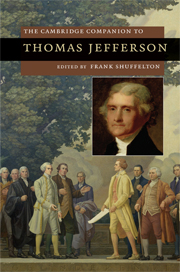Book contents
- Frontmatter
- Introduction
- 1 The Declaration of Independence and the new nation
- 2 Jefferson’s conception of republican government
- 3 Notes on the State of Virginia and the Jeffersonian West
- 4 Jefferson and Native Americans: policy and archive
- 5 Race and slavery in the era of Jefferson
- 6 Jefferson’s people: slavery at Monticello
- 7 Jefferson, science, and the Enlightenment
- 8 Thomas Jefferson and the creation of the American architectural image
- 9 The politics of pedagogy: Thomas Jefferson and the education of a democratic citizenry
- 10 Jefferson and religion: private belief, public policy
- 11 Jefferson and the language of friendship
- 12 Jefferson and Adams: friendship and the power of the letter
- 13 The resonance of minds: Thomas Jefferson and James Madison in the republic of letters
- 14 Jefferson and the democratic future
- Further reading
- Index
8 - Thomas Jefferson and the creation of the American architectural image
Published online by Cambridge University Press: 28 May 2009
- Frontmatter
- Introduction
- 1 The Declaration of Independence and the new nation
- 2 Jefferson’s conception of republican government
- 3 Notes on the State of Virginia and the Jeffersonian West
- 4 Jefferson and Native Americans: policy and archive
- 5 Race and slavery in the era of Jefferson
- 6 Jefferson’s people: slavery at Monticello
- 7 Jefferson, science, and the Enlightenment
- 8 Thomas Jefferson and the creation of the American architectural image
- 9 The politics of pedagogy: Thomas Jefferson and the education of a democratic citizenry
- 10 Jefferson and religion: private belief, public policy
- 11 Jefferson and the language of friendship
- 12 Jefferson and Adams: friendship and the power of the letter
- 13 The resonance of minds: Thomas Jefferson and James Madison in the republic of letters
- 14 Jefferson and the democratic future
- Further reading
- Index
Summary
The importance for Thomas Jefferson of a building's design and appearance is revealed in his observation: “Architecture is my delight, and putting up and pulling down one of my favorite amusements.” As a plantation owner, he needed functional structures and he designed them along with his dwellings, whether in Virginia, Philadelphia, or Paris. His main house, Monticello, became a life-long experiment in new ideas and forms. He took obvious pride in the praise it engendered, as with the Duc de la Rochefoucauld-Liancourt's observation that Monticello “was infinitely superior to all other houses in America.” During the Frenchman's visit in 1796, Jefferson showed him a scheme for a major rebuilding and Rochefoucauld-Liancourt claimed that the new Monticello: “will certainly deserve to be ranked with the most pleasant mansions in France and England.” Jefferson also saw architecture as existing with a public purpose. He explained that he drew upon the first-century BC, Roman, Maison Carrée in Nîmes, France, for the new Virginia State Capitol in Richmond because “How is a taste for a chaste & good style of building to be formed in our countrymen unless we seize all occasions which the erection of public buildings offers, of presenting to them models for their imitation?” He advised Americans who might travel in Europe to look at the paintings and sculpture; however, architecture was “among the most important arts,” and, along with gardens, the only one worthy of real study. Buildings, as Jefferson knew, had a purely functional element: they provided shelter, but also they should inspire and convey identity. He wrote to James Madison that the classical Virginia state house would “improve the taste of my countrymen, to increase their reputation, to reconcile them to the rest of the world, and procure them its praise.”
- Type
- Chapter
- Information
- The Cambridge Companion to Thomas Jefferson , pp. 114 - 126Publisher: Cambridge University PressPrint publication year: 2009



